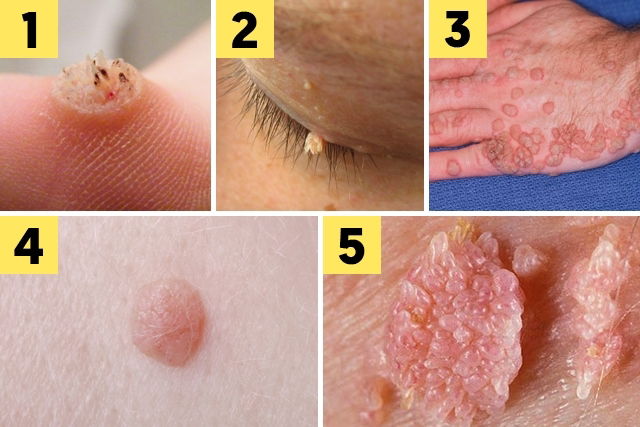Warts are small, non-cancerous (benign) and usually harmless skin growths caused by the HPV virus. They can occur at any age and anywhere on the body, such as the face, feet, groin, genital area, or hands.
Warts can appear alone or in groups and can easily spread from one area of the body to another.
They usually resolve without specific treatment, but the use of wart remedies can be helpful in speeding up this process.

Main types of warts
The 5 types of existing warts, classified according to their location and morphology, are:
- Plantar wart: This wart affects the feet and has a fisheye appearance. It is similar to a callus, since it is usually yellowish and has black dots inside;
- Filiform wart: This is a thin, elongated wart that appears mainly on the face or neck of elderly people;
- Common wart: This wart is usually less than 1 cm in diameter, firm to the touch, and usually has a rough, rounded or irregular surface. It may be skin-colored, grey, yellowish, brown or black;
- Flat wart: This is a small, flat-looking wart that appears in clusters. It is soft and occurs more frequently on the face;
- Genital wart: This is a wart that appears in the female or male genitalia. It has a higher risk of developing cancer compared to other warts. Genital warts are usually soft and pink in color.
It is important for warts to be assessed by a dermatologist to evaluate whether the warts are related to the presence of another infectious disease. The dermatologist can indicate the most appropriate treatment to remove them.
What causes warts
The transmission of warts occurs from direct contact with other warts, which means the HPV virus can be passed from one person to the other. Children are, generally, the most affected, as they tend to pick at warts.
It is important to point out that the HPV virus in warts only passes on to other individuals if it finds an area of the skin to penetrate, such as an ingrown toenail scratch or a wound, for example.
To decrease your risk of catching warts, you should:
- Avoid touching other people’s warts without using proper protection, like gloves
- Avoid public pools that are not properly cleaned with appropriate products
- Do not share towels with other people
You should also avoid walking around barefoot in locker rooms, around public pools and other common areas. You should try to use flip-flops or slides when possible.
Treatments to remove warts
There are different types of treatment available for the removal of warts that can be recommended by the dermatologist. The type of treatment used depends on the type of wart and its characteristics. There are some home remedies that can be used to help with wart removal, however these are usually used to complement treatment indicated by the doctor.
Some ways of removing warts are:
1. Use of medication
The dermatologist can indicate the use of some creams or ointments made with acetylsalicylic acid or lactic acid. These are applied directly on the wart, and can be used at home at least twice a day (or as prescribed by the doctor).
2. Cryotherapy
Cryotherapy is the most used and recommended thereapy. It consists of the application of liquid nitrogen in spray-form directly on the wart. The wart will usually fall off within a few days. This treatment should be completed in a doctor’s office to avoid skin burns, as liquid nitrogen is extremely cold.
3. Laser removal
Laser removal is indicated when the patient has many warts or if they are spreading. It is done under local anesthesia, as the procedure without analgesic can cause pain and discomfort. A laser ray is applied directly on the wart to destroy the tissue within the wart.
Following this procedure, patients should take care of the wound that appears after the wart falls off, as there is a risk for infection. This is also important for warts that are physically excised (cut off) by the doctor.
4. Duct tape
Duct tape is an easy way to remove warts, and it is recommended by the American Dermatologic Association. To remove the wart with duct tape, you should cover the wart with duct tape for up to 6 days, then remove the tape and soak the wart for a few minutes. Then file the skin with an emery board or pumice stone to remove the excess skin.
Some of these treatments should be done in the doctor’s office by a dermatologist. Treatments that are applied at home should only be used after approval by your doctor, to ensure you will be treating a wart and not another skin condition.
